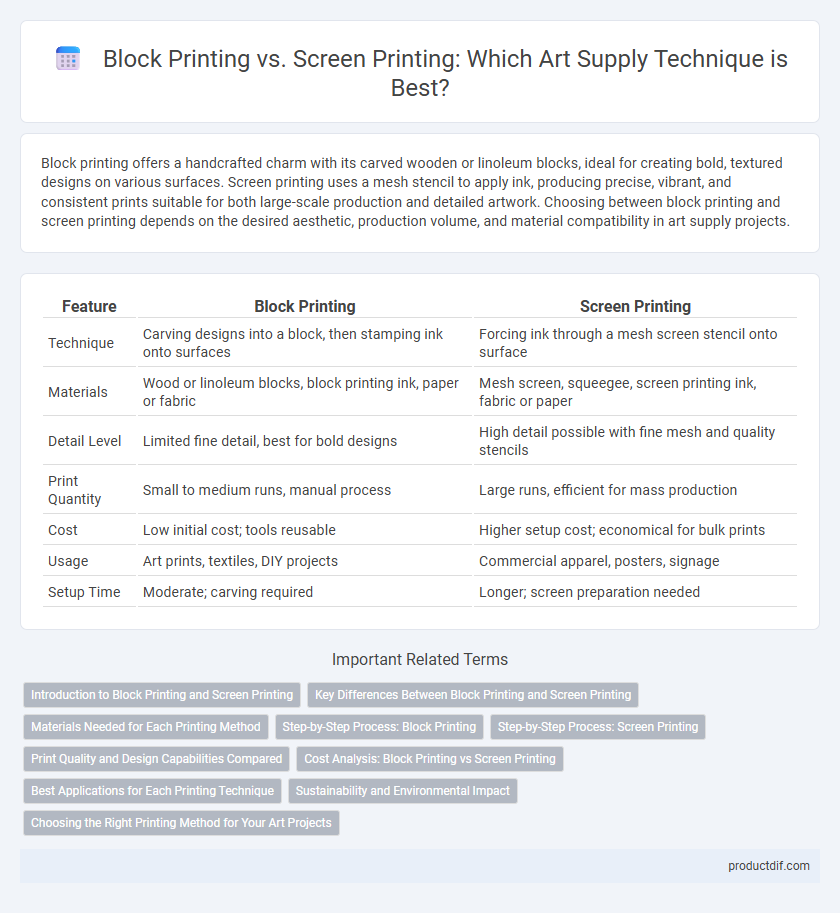Block printing offers a handcrafted charm with its carved wooden or linoleum blocks, ideal for creating bold, textured designs on various surfaces. Screen printing uses a mesh stencil to apply ink, producing precise, vibrant, and consistent prints suitable for both large-scale production and detailed artwork. Choosing between block printing and screen printing depends on the desired aesthetic, production volume, and material compatibility in art supply projects.
Table of Comparison
| Feature | Block Printing | Screen Printing |
|---|---|---|
| Technique | Carving designs into a block, then stamping ink onto surfaces | Forcing ink through a mesh screen stencil onto surface |
| Materials | Wood or linoleum blocks, block printing ink, paper or fabric | Mesh screen, squeegee, screen printing ink, fabric or paper |
| Detail Level | Limited fine detail, best for bold designs | High detail possible with fine mesh and quality stencils |
| Print Quantity | Small to medium runs, manual process | Large runs, efficient for mass production |
| Cost | Low initial cost; tools reusable | Higher setup cost; economical for bulk prints |
| Usage | Art prints, textiles, DIY projects | Commercial apparel, posters, signage |
| Setup Time | Moderate; carving required | Longer; screen preparation needed |
Introduction to Block Printing and Screen Printing
Block printing involves carving a design into a wooden or linoleum block, applying ink to the raised surfaces, and pressing it onto paper or fabric to create bold, textured prints. Screen printing uses a mesh screen stretched over a frame, with portions blocked off by a stencil, allowing ink to pass through the open areas onto the printing surface for vibrant, detailed images. Both techniques are popular in art supply stores for their unique effects and versatility in creating custom designs on various materials.
Key Differences Between Block Printing and Screen Printing
Block printing involves carving a design into a wooden or linoleum block, applying ink, and pressing it onto fabric or paper, resulting in bold, textured patterns with a handmade feel. Screen printing uses a mesh screen to transfer ink through stencils onto surfaces, allowing for more precise, multi-colored, and consistent prints ideal for mass production. The key differences lie in the techniques: block printing emphasizes manual carving and individual impressions, while screen printing focuses on stencil-based ink application for detailed, repeatable designs.
Materials Needed for Each Printing Method
Block printing requires materials such as carving blocks, linoleum or rubber sheets, carving tools, ink rollers, and printing paper, emphasizing tactile control and texture. Screen printing demands a mesh screen, photo emulsion, squeegee, stencil or design film, and specialized inks, focusing on precision and layered color application. Both methods use water-based or oil-based inks but differ significantly in setup and complexity of materials.
Step-by-Step Process: Block Printing
Block printing involves carving a design into a wooden or linoleum block, creating a raised surface that holds the ink. The artist applies ink evenly to the raised areas using a roller or brayer before pressing the block firmly onto paper or fabric to transfer the image. This traditional technique allows multiple prints of the original design with crisp, textured detail unique to each impression.
Step-by-Step Process: Screen Printing
Screen printing begins by creating a stencil on a fine mesh screen, followed by placing the screen over the printing surface such as fabric or paper. Ink is then pushed through the mesh using a squeegee, transferring the design onto the material beneath. This step-by-step process allows for vibrant, durable prints ideal for posters, apparel, and various art projects.
Print Quality and Design Capabilities Compared
Block printing offers rich texture and unique imperfections, creating a handcrafted aesthetic with limited color layering and detail precision. Screen printing excels in producing sharp, vibrant prints with complex color gradients and fine details, suitable for mass production. Design capabilities in screen printing accommodate multicolor and intricate patterns more effectively than block printing.
Cost Analysis: Block Printing vs Screen Printing
Block printing involves lower initial costs with basic tools like hand-carved blocks and inks, making it ideal for small-scale or personal projects. Screen printing requires investment in screens, stencils, and specialized equipment, resulting in higher upfront expenses but greater efficiency and scalability for larger print runs. Evaluating cost-effectiveness depends on print volume, complexity, and desired production speed in art supply budgeting.
Best Applications for Each Printing Technique
Block printing excels in creating bold, textured patterns on fabric, paper, and wood, making it ideal for artisanal crafts and limited-edition designs. Screen printing is best suited for producing vibrant, multi-colored images on textiles, posters, and promotional materials, offering high precision and scalability. Artists often choose block printing for its handcrafted aesthetic and screen printing for its efficiency in mass production.
Sustainability and Environmental Impact
Block printing uses hand-carved wooden blocks and water-based inks, producing minimal waste and reducing energy consumption, making it more sustainable. Screen printing relies on synthetic screens and chemical emulsions that generate hazardous waste and consume more water and electricity. Choosing block printing over screen printing minimizes environmental impact by promoting biodegradable materials and conserving resources.
Choosing the Right Printing Method for Your Art Projects
Block printing offers a tactile, hands-on approach perfect for small batches and intricate designs, ideal for artists seeking a traditional, textured finish. Screen printing excels in producing vibrant colors and sharp details at scale, making it suitable for larger runs and commercial projects. Assessing the project size, desired texture, and color complexity helps determine whether the artisanal charm of block printing or the efficiency of screen printing best matches your artistic vision.
Block Printing vs Screen Printing Infographic

 productdif.com
productdif.com